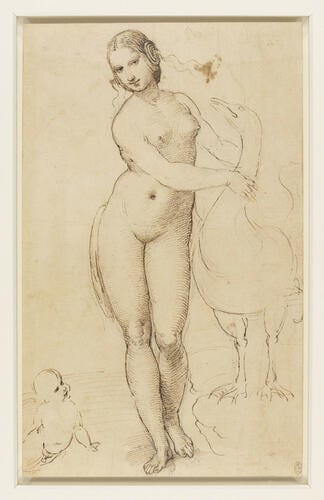-
1 of 253523 objects
Leda and the Swan c.1507
Pen and ink over black chalk underdrawing | 31.0 x 19.2 cm (sheet of paper) | RCIN 912759

Raphael (1483-1520)
Leda and the Swan c.1507

Raphael (1483-1520)
Leda and the Swan c.1507


-
A drawing of Leda with her arms around the neck of the swan, standing to the side of her; at lower left is an infant looking upwards.
The drawing is a copy of a composition of Leda and the Swan by Leonardo da Vinci. During the first two decades of the sixteenth century Leonardo worked on two variants of a composition of Leda with the swan - one in which the woman kneels, the other in which she stands. The kneeling version was under way by 1504, when Leonardo sketched her contorted figure three times on a sheet at Windsor (RCIN 912337) that also contains a study for his Battle of Anghiari. Fully worked drawings of the kneeling Leda by Leonardo are to be found at Chatsworth and Rotterdam. That format was apparently abandoned without a cartoon or painting being made, and Leonardo turned instead to an alternative of a standing Leda. He did execute a painting of this version, perhaps begun around 1514-15 and still in his studio at his death in 1519; the painting, then in the French royal collection, was destroyed around 1700 but its composition is known through numerous copies.
Although Raphael could have seen Leonardo's designs for the Leda during the time they were both in Rome (1513-1516), the style of this drawing indicates that it was executed before Raphael left Florence in 1508, and as such it gives the earliest secure date for Leonardo's work on a standing Leda. Raphael's model was almost certainly a drawing rather than a painting: the modelling, with lines curving around the forms of the woman, is different from Raphael's usual straight hatching and was based on Leonardo's mode at that time. Indeed the many copies of this composition agree generally in the forms of Leda and the swan but differ greatly in the backgrounds and the children, suggesting that most were made from a cartoon or other drawing in which these elements were barely indicated, rather than from a finished painting.
Raphael's Leda is also an adaptation of its model and not a faithful copy. A red-chalk drawing in the Louvre (inv. 2563), probably made from the same original, records the serpentine neck of the swan that Raphael reduced to a more columnar form, like the neck of a goose. The ambivalence of Leonardo's design, with Leda both embracing and squirming away from the swan (and looking away from the spectator), is here replaced by a calm and balanced pose. This Leda from the waist down served three or so years later as the model for the Eve in Raphael's Temptation on the ceiling of the Stanza della Segnatura in the Vatican.
A drawing at the National Galleries of Scotland (D 1645) is a tracing after this one, probably by F.C. Lewis in preparation for his etching published in 1809.
On the verso is inscribed, upper left in ink, peze 16, presumably an early price mark.
Text adapted from M. Clayton, Raphael and his Circle, 1999, no. 12.Provenance
First recorded in a Royal Collection inventory of c.1810 (Inv. A, p.51, ‘Raffaello d'Urbino e Scuola’, no. 37: ‘A Leda, drawn with a Pen’)
-
Creator(s)
(artist) -
Medium and techniques
Pen and ink over black chalk underdrawing
Measurements
31.0 x 19.2 cm (sheet of paper)
Category
Object type(s)